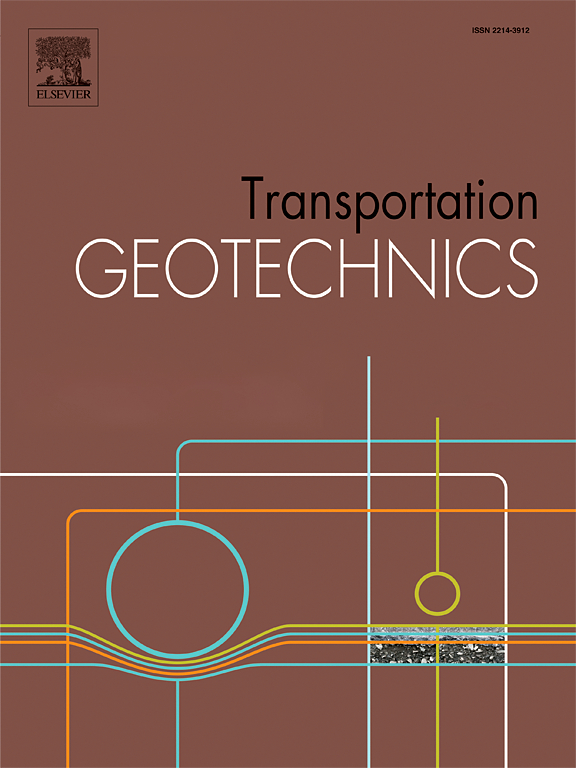Experimental and numerical studies on geosynthetic encased stone columns in saturated and unsaturated soils
IF 4.9
2区 工程技术
Q1 ENGINEERING, CIVIL
引用次数: 0
Abstract
Geosynthetic encased stone columns are conventionally designed based on the principles of saturated soil mechanics ignoring in-situ unsaturated conditions. Such an approach results in over conservative and, in certain scenarios, unrealistic designs. A more rigorous approach is required for design of stone columns considering the influence of saturated and unsaturated soil conditions taking account of area replacement ratio of stone columns and the stiffness of geosynthetic encasement considering site specific conditions. However, such an approach is presently not available in the literature. For this reason, in this study, 42 physical model tests were conducted that suggest an increase in carrying capacity of stone columns by 14 times understand unsaturated conditions in comparison to saturated conditions for the soil tested. A non-linear increase in load-bearing capacity was observed in boundary effect and primary transition zones while a decline was noted in secondary transition and residual zones due to reduced matric suction contribution. Additionally, comparisons were drawn using 3D finite element analyses, which were extended to prototype-scale studies to understand variations in confining pressure and soil deformation around stone columns in unsaturated conditions. The numerical results validated the experimental results, showing a 50% reduction in settlements due to the contribution of matric suction. Finally, a simple framework is proposed for predicting the load-carrying capacity of encased stone columns extending the mechanics of saturated and unsaturated soils. The rational design methodology summarized in this study for extending it into geotechnical engineering practice can contribute to potential cost savings by optimizing geosynthetic stiffness, stone column diameter, and area replacement ratio.
饱和与非饱和土中土工合成包壳石柱的试验与数值研究
土工合成围护石柱的设计通常基于饱和土力学原理,忽略了原位非饱和条件。这样的方法导致过度保守,在某些情况下,不切实际的设计。考虑饱和和非饱和土条件对石柱的影响,考虑石柱的面积替换率,考虑场地具体情况的土工合成围护结构刚度,需要更严格的石柱设计方法。然而,这种方法目前在文献中是不可用的。因此,在本研究中,进行了42次物理模型试验,表明石柱的承载能力在非饱和条件下比在饱和条件下增加了14倍。边界效应区和初级过渡区承载能力呈非线性增长,而二次过渡区和残余区承载能力由于基质吸力贡献的减少而下降。此外,采用三维有限元分析进行比较,并将其扩展到原型尺度研究,以了解非饱和条件下石柱周围围压和土壤变形的变化。数值结果验证了实验结果,表明由于基质吸力的贡献,沉降减少了50%。最后,通过对饱和和非饱和土力学的扩展,提出了一种简单的圈层石柱承载力预测框架。本研究总结的合理设计方法将其推广到岩土工程实践中,可以通过优化土工合成材料刚度、石柱直径和面积替代比来节省潜在的成本。
本文章由计算机程序翻译,如有差异,请以英文原文为准。
求助全文
约1分钟内获得全文
求助全文
来源期刊

Transportation Geotechnics
Social Sciences-Transportation
CiteScore
8.10
自引率
11.30%
发文量
194
审稿时长
51 days
期刊介绍:
Transportation Geotechnics is a journal dedicated to publishing high-quality, theoretical, and applied papers that cover all facets of geotechnics for transportation infrastructure such as roads, highways, railways, underground railways, airfields, and waterways. The journal places a special emphasis on case studies that present original work relevant to the sustainable construction of transportation infrastructure. The scope of topics it addresses includes the geotechnical properties of geomaterials for sustainable and rational design and construction, the behavior of compacted and stabilized geomaterials, the use of geosynthetics and reinforcement in constructed layers and interlayers, ground improvement and slope stability for transportation infrastructures, compaction technology and management, maintenance technology, the impact of climate, embankments for highways and high-speed trains, transition zones, dredging, underwater geotechnics for infrastructure purposes, and the modeling of multi-layered structures and supporting ground under dynamic and repeated loads.
 求助内容:
求助内容: 应助结果提醒方式:
应助结果提醒方式:


